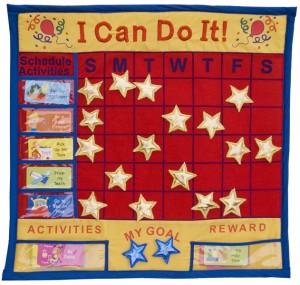Neither of us have done reward or behavior charts yet, but we were so inspired when mama, Amanda, sent this great article to us! I am ready to get one myself :) Also, I have highlighted some of my favorite parts just in case you don’t have time to read the entire thing! Thanks to Orange Cast for the great article!
“A behavior modification chart, commonly referred to as a behavior chart, is a teaching aid used by many parents and schoolteachers to reinforce good behavior in children while discouraging misbehavior. There are a wide variety of behavior charts available, which often serve to teach children different lessons. Two of the most common behavior charts are used to either discipline or reward children.
Many will recall their days of elementary school and the behavior chart that many teachers use. The most common classroom behavior chart is relatively basic and usually has four or five colored card in slots on the chart. Children will start each day with a full count of cards. As the day progresses, any child that misbehaves or acts out will have to remove a card. The amount of cards left will determine the consequences for the child’s actions. Usually, a child pulling one card will receive a warning, two cards removed will result in a time out, often enforced at recess or free time, and so on. While this type of teaching aid is quite common, some argue that this method is not effective, as it does nothing to reinforce positive behavior. It is thought that by only reinforcing discipline, children are not properly taught why to use good behavior, only how to avoid bad punishment.
While a behavior chart such as this is an effective teaching aid in the classroom, where there is more of an emphasis on preventing classroom disruptions, at home, parents need a teaching aid that can emphasize good choices rather than simply teaching the child how to avoid punishment. Additionally, parents are seeking to instill good habits in their children, teaching them responsibility and the rewards of virtue.
There are a number of household chores and actions that many parents often have trouble encouraging their children to do. These activities include motivating children to pick up their toys, make their bed, and brush their teeth. While it is easy to punish a child by taking away privileges until the chores are done, this simply teaches a child to avoid punishment, which is not always the most effective means of motivation.
There are other developmental situations in which punishment is not effective at all, and in fact can be harmful to a child’s development. The issue of potty training is one of these situations. Potty training is a situation that is extremely unfamiliar to a child. They are taken out of their comfort zone and placed in an unfamiliar situation. It is important that parents instill confidence in their child and show the child that they can do it on their own. In potty training, punishment is not a motivation. Instead it is important to instill confidence and a sense of achievement through goals.
According to Roxana Bolanos, of Learning From A to Z, “With an emphasis on the negative, telling a child no, the child does not see the benefits of good behavior or right actions, only the consequences of acting up. It is important that a child realizes the rewards for good behavior, which encourages them to obey and conduct themselves accordingly.”
Many parents and educators have begun to focus on the reinforcement of good behavior and look for a more positive teaching aid that emphasizes rewards and positive motivation. The thought is that encouraging good behavior in children, such as completing chores or being polite, is more effective than simply punishing a child when he or she misbehaves. There are several behavior charts that have been developed to reinforce this good behavior.
According to Roxana Bolanos, “To encourage good behavior, we developed the concept of a reward chart, which does not emphasizes punishment and discipline, but instead focuses on the rewards of right behavior to instill confidence through meeting goals.“
A reward chart is different than a standard behavior chart used in classrooms. A reward chart is a teaching aid that is designed to set goals for a child and reward them when certain goals are met. The goals can cover a wide array of topics including potty training, accomplishing chores, and manners.
One example of a reward chart is the “I Can Do It! Reward Chart” offered by Learning From A to Z. The “I Can Do It! Reward Chart” allows a parent or child to choose five activities to work on in a given week. These activities include making the bed, cleaning up toys, being polite, brushing teeth, and sharing. The child or parent can also choose a reward that the child can earn at the end of the week for good behavior. Every day that the child meets their behavioral goal, the child receives a gold star. If by the end of the week, the child has earned enough stars, they will be given a reward.
While a behavior chart can prove to be an excellent teaching aid, it is only effective in certain situations and environments, where punishment is an effective motivation. Other situations, such as potty training, or enacting long-term behavioral modification, require a different motivational tool, such as a reward chart. Reward charts are a very effective teaching aid for several reasons. They encourage good behavior rather than discourage misbehavior. They teach children about setting goals for oneself, and finally they instill confidence in a child when he or she meets certain goals, allowing the child to see the progress they are making.
“It is important to get children involved,” said Roxana Bolanos. “With a reward chart, children can take an active participation in setting behavioral goals and choosing what would best motivate them to achieve these goals. A reward chart teaches children self discipline as well as introducing the concept of setting goals for oneself.”
Learning from A to Z has some AMAZING teaching aids! Some of these include: books, educational calendars, educational toys, reward charts and learning aids. Which is your favorite?? How do you think this would work in your household?








{ 7 comments… read them below or add one }
Be careful with these. Very easy way to instill external motivation on your kids instead of internal motivation. This is exactly why most kids grow up expecting things for doing stuff they should do anyway. Currently not a fan of reward charts! Read Madelyn Swift's Discipline for Life – Getting it Right with Children for another perspective. It makes much more sense to me.
Yes, it is interesting you say this. I definitely don't believe in bribery (you do this and I will give you that), but when I read this I felt it was different because they are setting the goal and having to work toward completing that goal over a period of time to get the reward (vs. clean up your toys and I will give you a treat). I haven't done any more research into rewards charts other than this article so I will surely look into it further and read your book suggestion before I make any final decisions! Thanks for your input!!! Jennie
Thanks for your comment Tricia, I was at the same conference with you when we heard them talk about rewards. Her book is a great resource!
Our Chart is working like a charm. Ava's rewards she has chosen so far… are things we already do. Like a movie night (at home with mommy and daddy with popcorn and blankets and a movie of her choice) which she loves to do and we already do but we are just making a bigger deal about it and letting her know that if she behaves and meets her goal of last week 15 stars and this week 20 stars we get to enjoy more time together – time I would have been spending picking up her room or making her bed, etc. for her. It is working for us! However, if you are buying rewards for them I could see a danger there. Good point! Thanks for the shout out Jen! I love the OneStepAhead – reward chart – they can pick their own chores or goal for the week and their own reward. Gives her something to visable see and work toward and she loves to put her own stars on and count them. It is secretly helping her learn to count and the days of the week etc. :)
That is great to hear, it sounds like Ava is really responding to the charts! Thanks for sharing girl, I love it! – Kim :)
A- love it!
I’ve been using reward charts for many years and had some great success with them, i’ve gotten some personalised ones with the kids names on from http://www.personalisedrewardcharts.co.uk which seem to help give them a bit of accountability and ownership to the chart as well